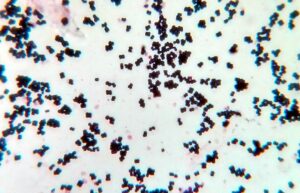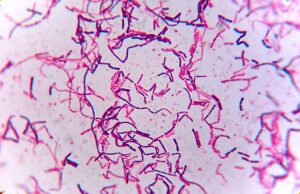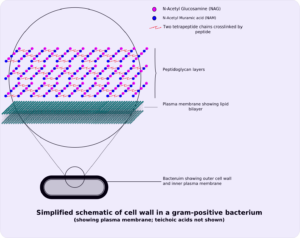The gram positive bacteria appear purple in colour in gram staining because of the presence of the thick peptidoglycan layer.
The gram positive bacteria retains purple or violate color which is used for gram staining process as they have thick peptidoglycan layer. Here we shall discuss more on gram positive bacteria examples.
In this article we shall discuss in detail about gram positive bacteria.
Gram Positive Cocci:
- Coagulase positive: e.g. S.aureus
- Coagulase negative: e.g. S. epidermidis

Gram Positive Bacilli:

History:
Gram staining technique was developed by Hans Christian Gram. The technique is known as Gram staining. By this technique we can differentiate bacterial species into two types Gram-positive bacteria and Gram-negative bacteria. The crystal violate stain is used in gram staining.
When observed through an optical microscope, the bacteria which contains mesh-like cell wall made of thick peptidoglycan layer takes crystal violet and appears in purple. They are named Gram-positive bacteria. Whereas the bacteria which contains thin cell wall takes saffranin and appear in pink are called gram negative bacteria.
Because of the presence of the thick peptidoglycan layer and absence of outer membrane the gram positive bacteria are more susceptible to antibiotics than gram negative bacteria.

Cell structure:

Read More On :Do All Bacteria Do Photosynthesis: Why, What Type, How And Detailed Facts
Read More On : Do Bacteria Have Vacuole: Detailed Insights and Facts
Frequently Asked Questions:
What are the common infections caused by gram positive bacteria?
Anthrax, Diphtheria, Diarrhea, Meningitis, Nausea, Skin infections Urinary tract infections.
What are the most common gram positive bacteria?
streptococcus pyogenes, Streptococcus pneumoniae, Staph. epidermidis, Staph. saprophyticus and Enterococcus faecalis.
How the gram positive bacteria replicate?
The gram positive bacteria undergo replication with the help of self replicating plasmids.
The plasmids present in bacterial cell involve in the replication of bacteria. The transcriptional repressor protein and anti sense RNA control the replication process.
What is a plasmid and its role?
A Plasmid is small circular double stranded DNA present in bacterial cells.
A plasmid is circular DNA present in bacterial cells naturally. It helps the bacteria in the development of antibiotic resistance.
Also Read:
- Does translation occur in the cytoplasm
- What does chloroplast store
- Ectoparasite examples
- Soil bacteria examples
- Butterflies characteristics
- Meiosis stages 2
- Obligate anaerobes
- Is lipase an enzyme
- Commensalism examples
- Nucleic acid vs nucleotide

Hi…I am Nagasrilakshmi Narne, a postgraduate in Biotechnology and English. also completed my B.Ed. I worked in Vimtalabs as a project trainee and I have work experience as a faculty of English. So I can explain topics in simple language.
Let’s connect through LinkedIn